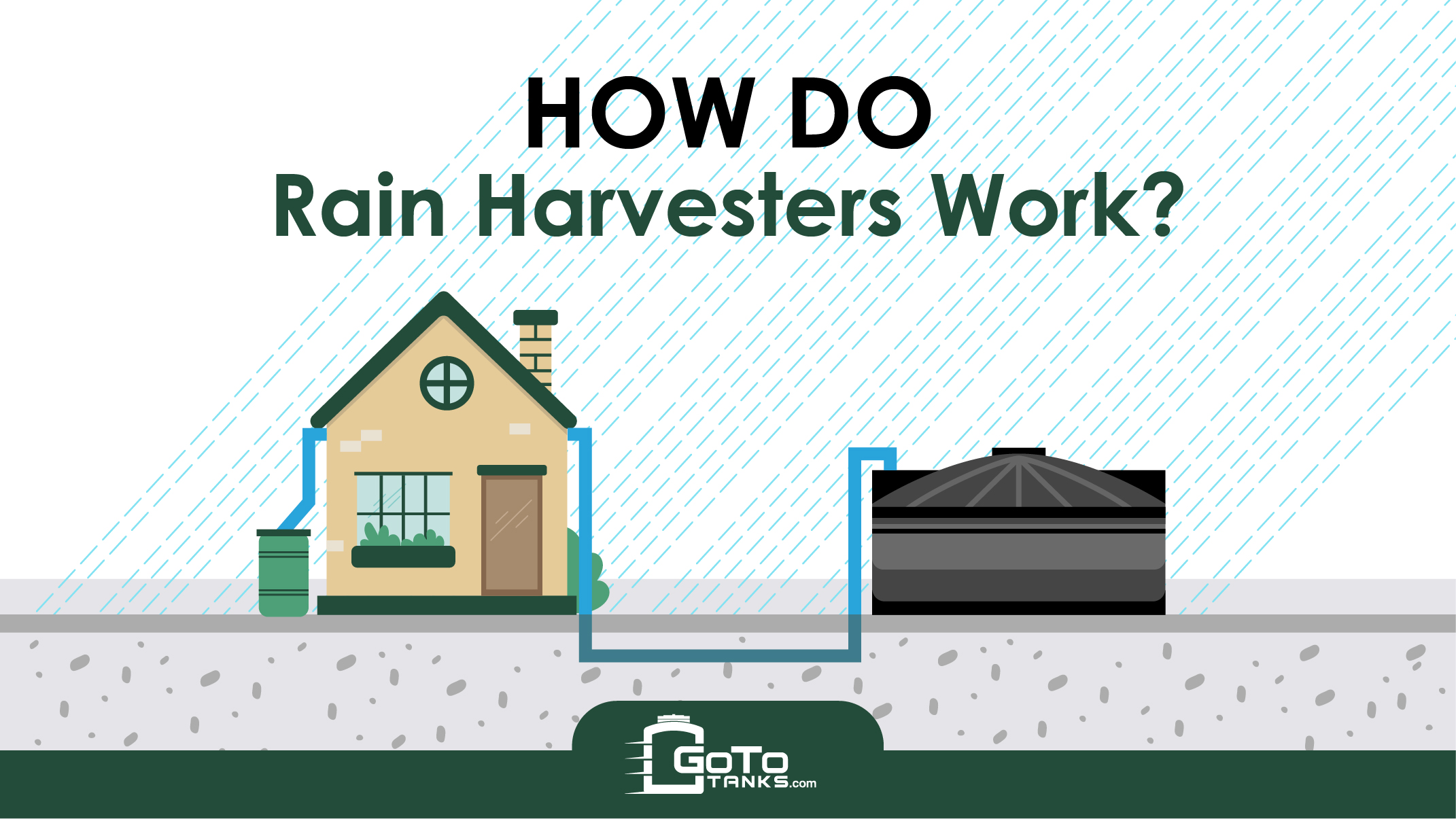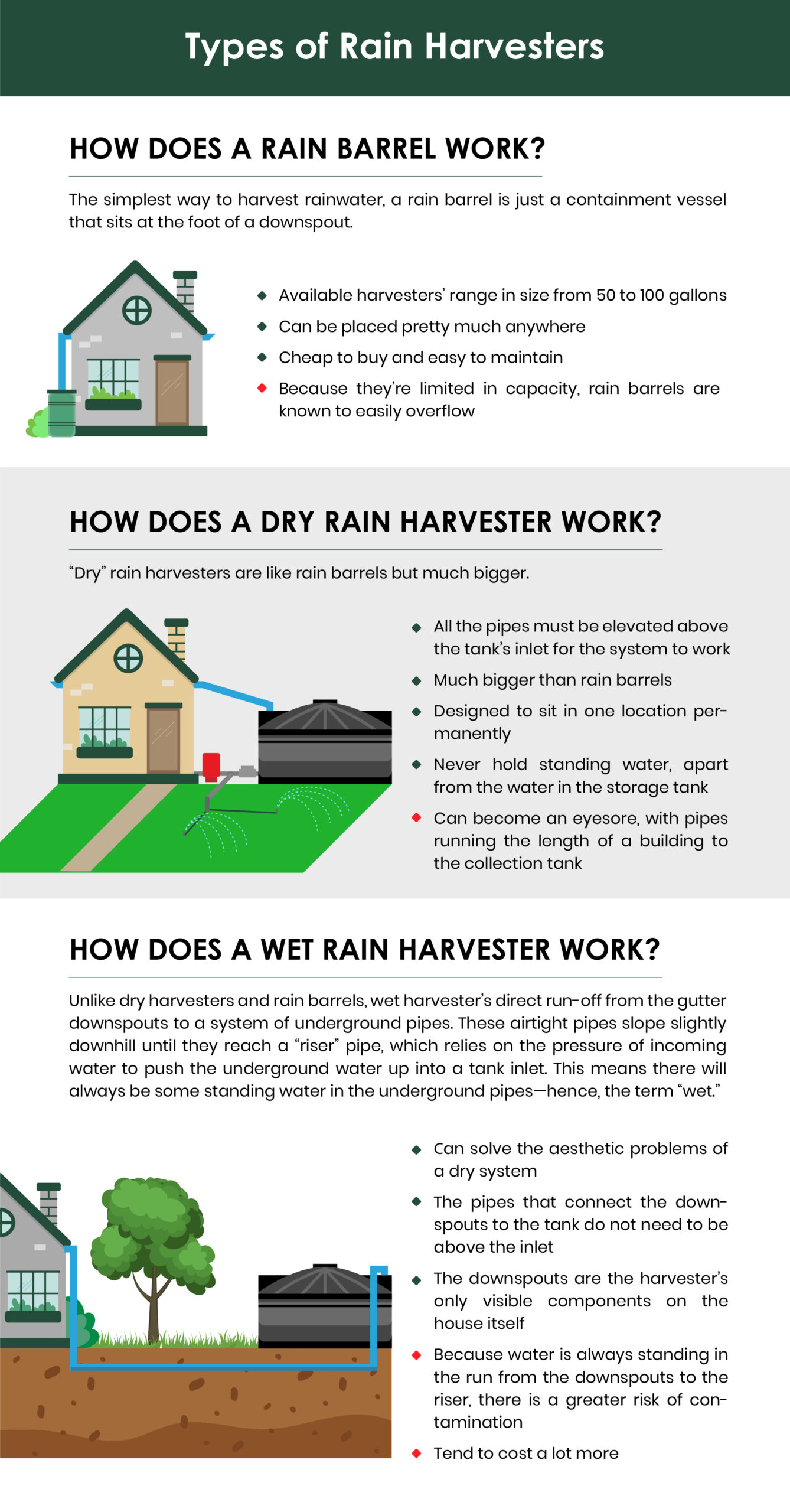
Rainwater harvesting refers to the process of gathering run-off from buildings, surfaces, or other “catchment” areas and directing it to a storage tank. It is a cheap and efficient way to collect water from your environment, without taxing municipal or groundwater supplies. There are several advantages to installing rain harvesters. They promote self-sufficiency while sustainably collecting water from the earth’s natural water cycles. What’s more, it’s a completely free source of water that requires virtually no energy to gather.
There are several types of rain harvesters, from simple rain barrels to sophisticated underground catchment systems. If you’re trying to decide which type of rain harvester to install on your property, it helps to first consider the different ways in which a harvester can be used.
The most obvious advantage of a rain harvester is that it supplies a completely free source of water. There’s also little to no energy needed to collect rain, as harvesters mostly rely on gravity and pressure differentials to direct and pump water into tanks. (If you plan to direct your storage tank to a plumbing system, you’ll likely require a pump.)
Here are a few more advantages that rain harvesters provide:
What you use harvested rainwater for depends on your climate, region, or neighborhood. City dwellers may appreciate having a source of water that is free and not limited to local ordinances. Rural homeowners appreciate the self-sufficiency of an on-site water source that isn’t as expensive to build as a well. For homes in arid climates, collecting run-off is just a sensible way of preserving water for whatever purpose.
Increasing in sophistication, there are three basic kinds of rainwater harvesting systems: rain barrels, dry harvesters, and wet harvesters. All serve the basic purpose of collecting run-off and directing it to a storage tank, but they differ in capacity and in the design of the water delivery mechanisms.
How Does a Rain Barrel Work?
The simplest way to harvest rainwater, a rain barrel is just a containment vessel that sits at the foot of a downspout. Rain collects in a building’s roof gutters and is channeled to the downspout, which then dumps the water into the rain barrel. The barrel can be specifically designed for rain harvesting, including a spigot, filter screen, and overflow fitting; or it can be a simple tank that you opt to fit and install yourself.
Rain barrels are attractive for their simplicity. Usually capable of holding no more than 60 gallons of water, they can be placed pretty much anywhere. They’re also extremely easy to install. All you must do is plant the barrel beneath a downspout. Depending on the system, you can suspend the downspout right above the barrel, or you can connect a hose from the downspout to the intake, which helps to keep debris and insects from getting into the water supply. As plastic tanks, rain barrels are cheap to buy and easy to maintain.
While simple and convenient, rain harvesters are limited in size. Of the three major types of harvesters, rain barrels fit the smallest amount of water. Most commercially available harvesters’ range in size from 50 to 100 gallons. That may be enough for some users, but if you intend to rely on a catchment system for most of your water needs, then that likely won’t cut it. And, because they’re limited in capacity, rain barrels are known to easily overflow. Without an overflow system, collected rain can easily be wasted during storms as water spills out of the tank.
How Does a Dry Rain Harvester Work?
“Dry” rain harvesters are like rain barrels but much bigger. In fact, a rain barrel is pretty much just a downsized dry catchment system. Dry harvesters work by collecting run-off from a roof gutter system. They then channel the rain to one or two downspouts, which in turn direct the water to a collection tank. All the pipes must be elevated above the tank’s inlet for the system to work, as it is propelled entirely by gravity.
Consider getting a dry system if you need to collect more water than what a rain barrel can supply. It also helps to have a simple catchment area with a clear flow of water. Dry harvest tanks are much bigger than rain barrels and are designed to sit in one location permanently. This secures a consistent supply of water that can be augmented with filters, screens, and even electric pumps to direct the supply to a household plumbing system. Unlike wet harvesters, dry systems never hold standing water, apart from the water in the storage tank. This makes the supply cleaner and more resistant to contamination.
The larger and more complicated a gutter system, the more downspouts and pipelines may be needed. In such cases, a dry system can become an eyesore, with pipes running the length of a building to the collection tank. Because the tanks themselves are much larger than rain barrels, you will have the challenge of locating the system where it does not blemish the look and charm of your home. With some storage tanks capable of holding thousands of gallons, that can be a challenge.
How Does a Wet Rain Harvester Work?
“Wet” rain harvesters can solve the aesthetic problems of a dry system, but they tend to cost a lot more. Unlike dry harvesters and rain barrels, wet harvester’s direct run-off from the gutter downspouts to a system of underground pipes. These airtight pipes slope slightly downhill until they reach a “riser” pipe, which relies on the pressure of incoming water to push the underground water up into a tank inlet. This means there will always be some standing water in the underground pipes—hence, the term “wet.” Because the pitch of the underground pipe needs to allow enough water pressure to force rainwater up the riser pipe, these systems require more detailed planning and installation.
With buried pipes, you can locate a wet storage tank far from the catchment area, thereby eliminating the eyesore problem associated with dry harvesters. Homes with large or complex roof designs may benefit from a wet system, as the pipes that connect the downspouts to the tank do not need to be above the inlet; they can be buried underground. The downspouts are the harvester’s only visible components on the house itself.
Most wet harvesting systems warrant a large property, where the storage tank can be placed far from the home. Because water is always standing in the run from the downspouts to the riser, there is a greater risk of contamination. If the system is not adequately sealed, insects, dirt, and bacteria can intrude and infect a batch of collected water. Some systems are fitted with a diverter to redirect standing water and only admit fresh rainwater. Another option is to bury the storage tank so that the inlet is below the downspouts, but this may add considerable expense to the project while opening up a variety of maintenance challenges.

It depends, first and foremost, on how much rainwater you want to collect. While it’s better to overestimate rather than underestimate your needs, if you only mean to supply a secondary source of water for gardening or cleaning, then a simple rain barrel should suffice. If you mean to rely on rain as your primary source of water, then you need a wet or dry system. Dry systems work well in most situations, but if you’re concerned about the messy, industrial look of an above ground rain harvester then you should consider installing a wet system.
Whatever you end up with, Go To Tanks has a large selection of water storage tanks for any type of rain harvesting system. Our tanks range in capacity from 20 to 10,000 gallons, and are available in a variety of styles, shapes, and colors. Regardless of your rain harvesting needs, we can help you find the right tank for your property.
Call 1-877-468-2657 to get started today!